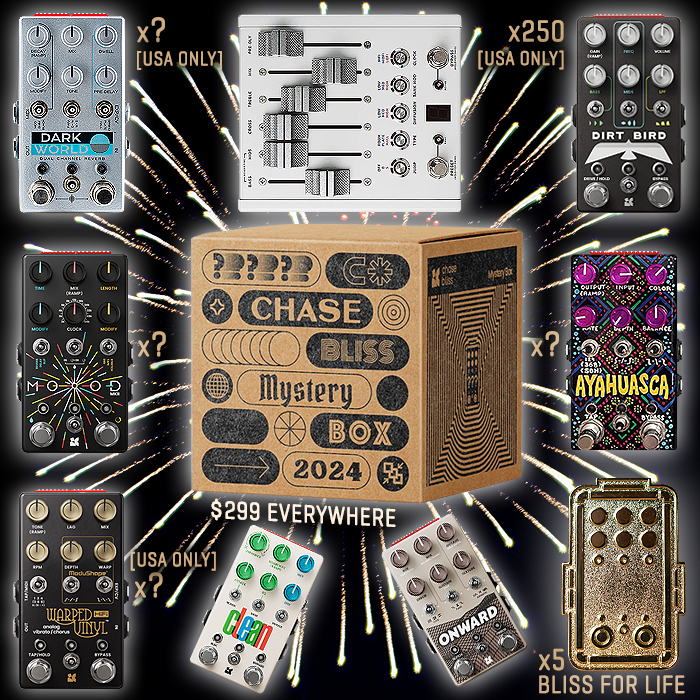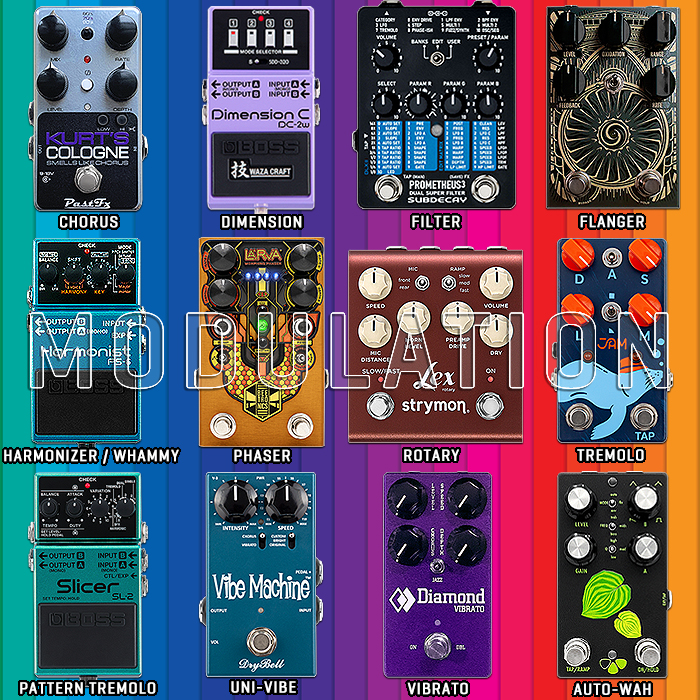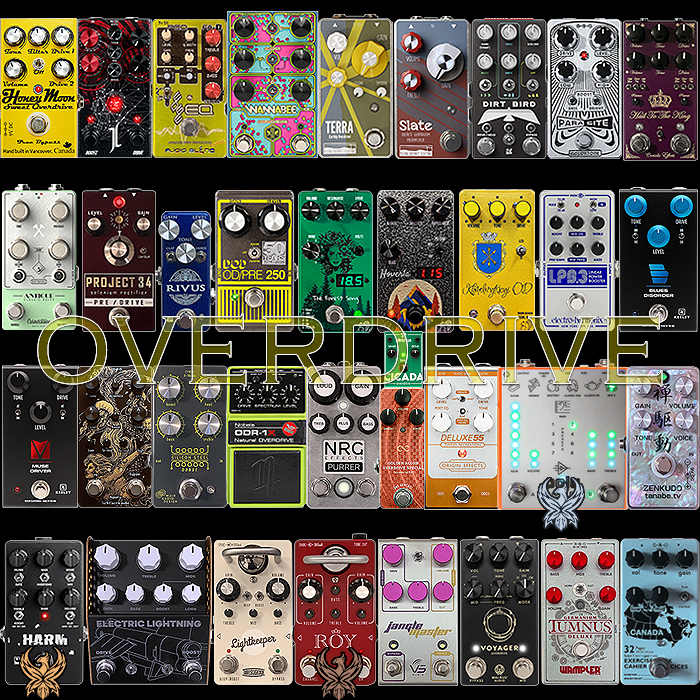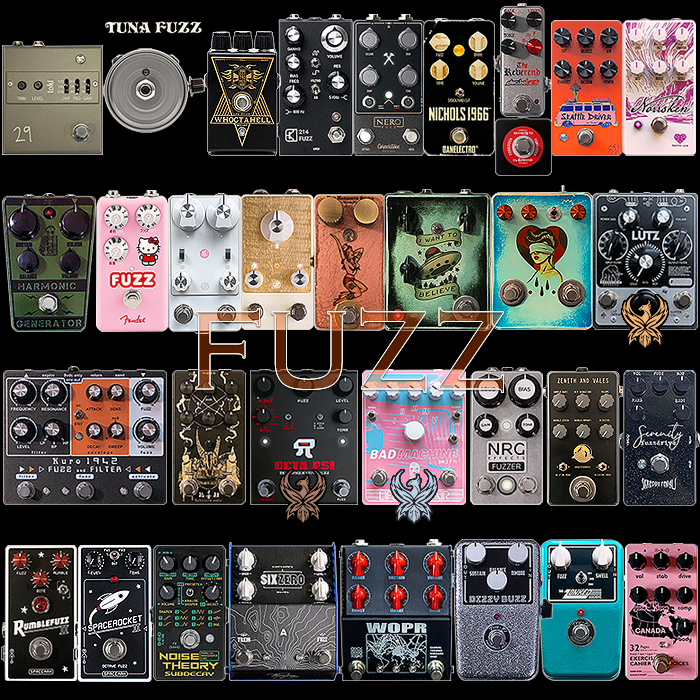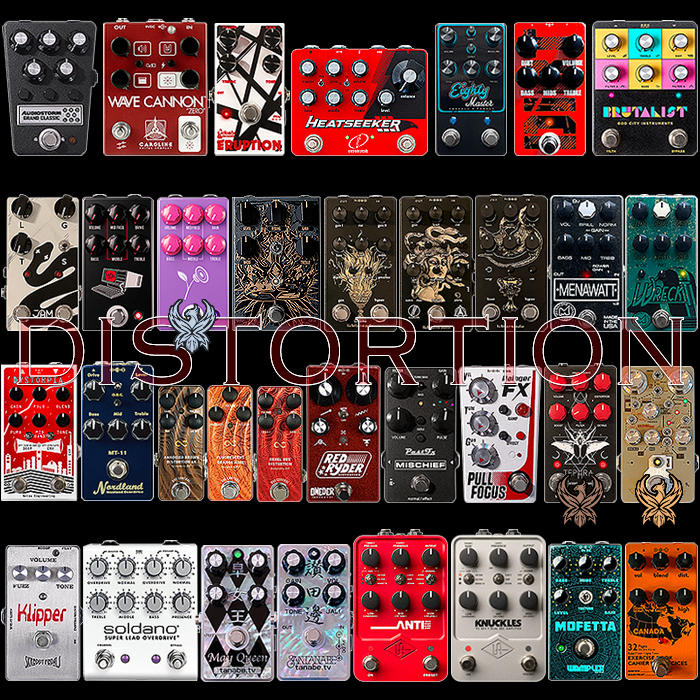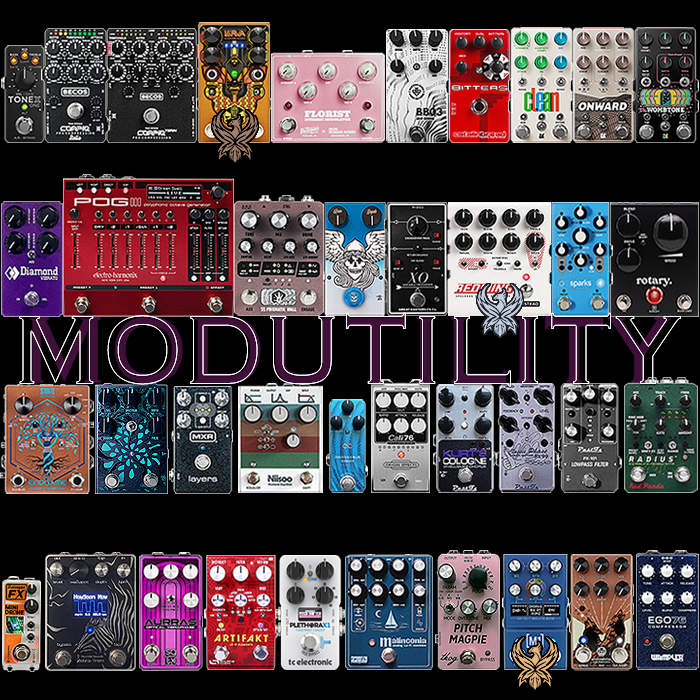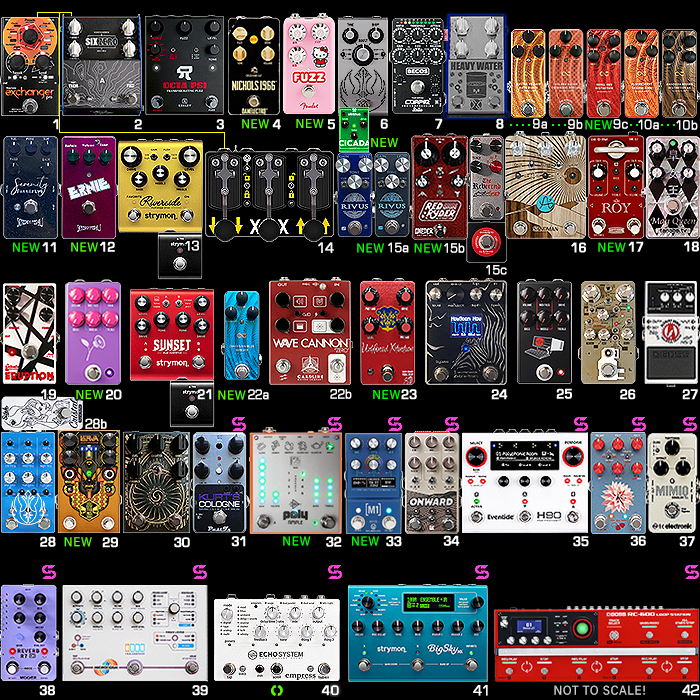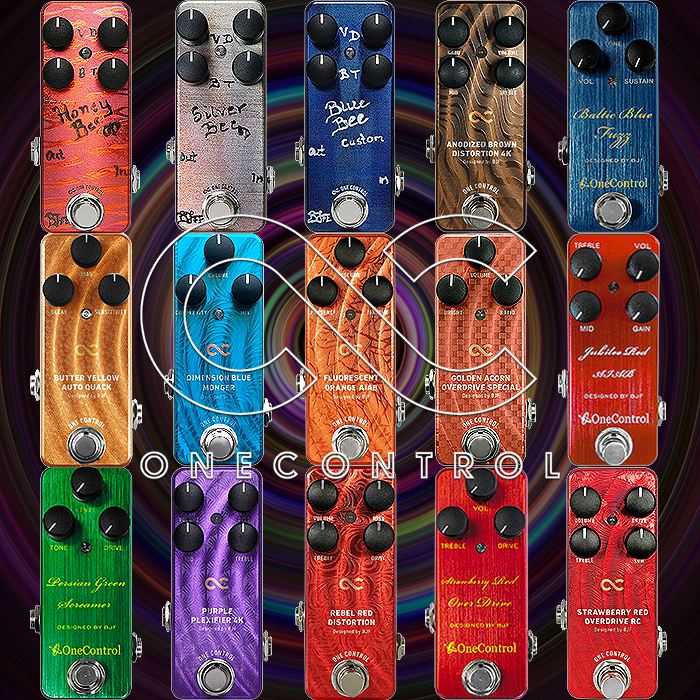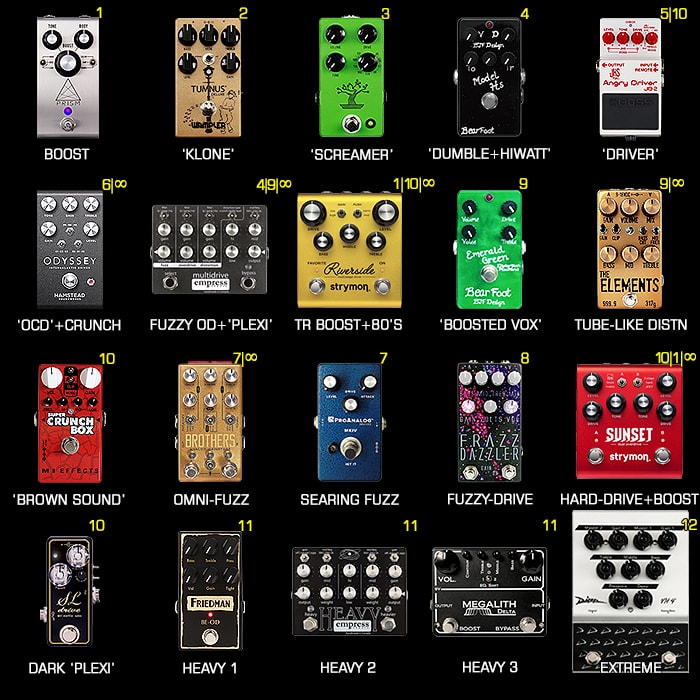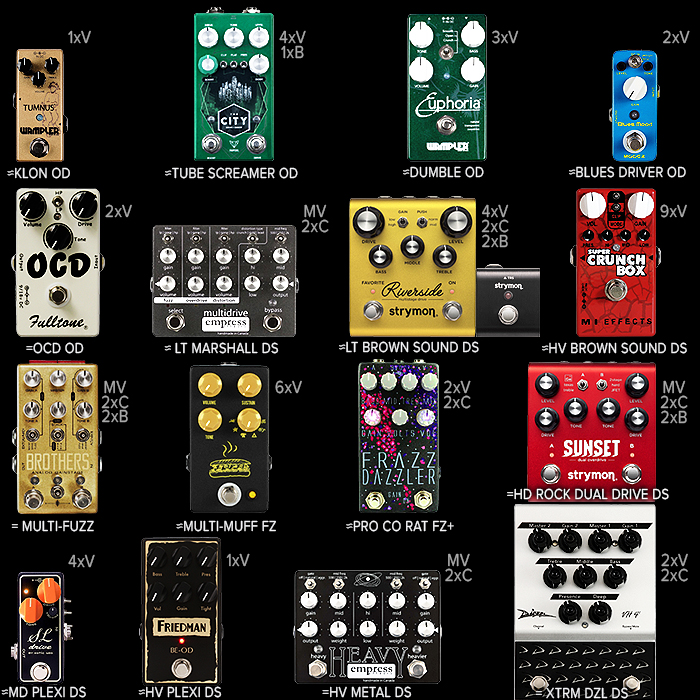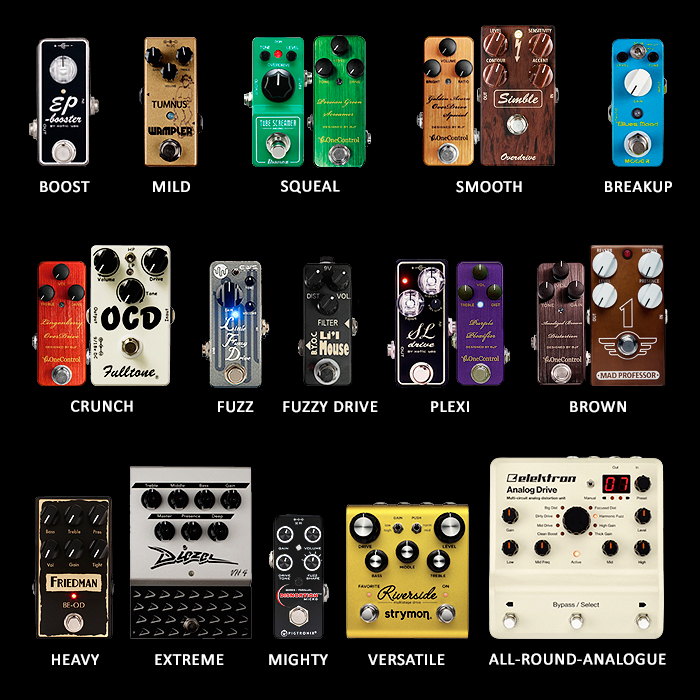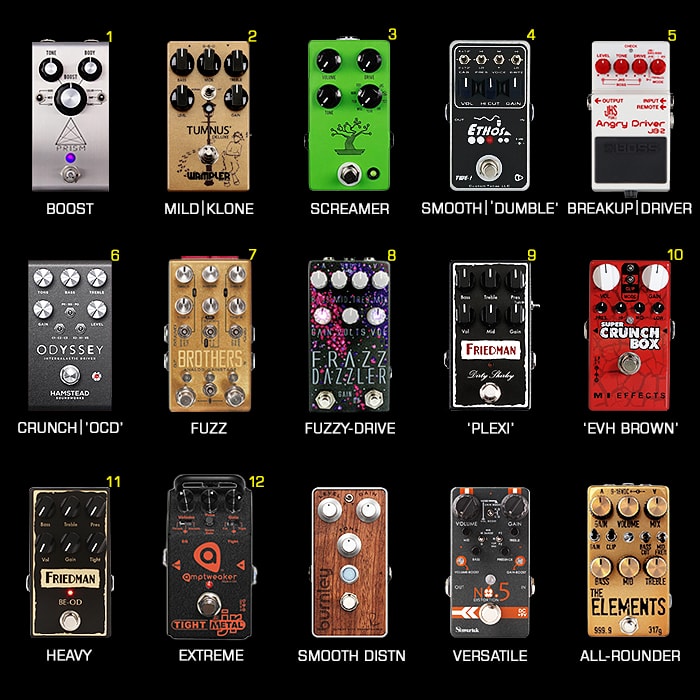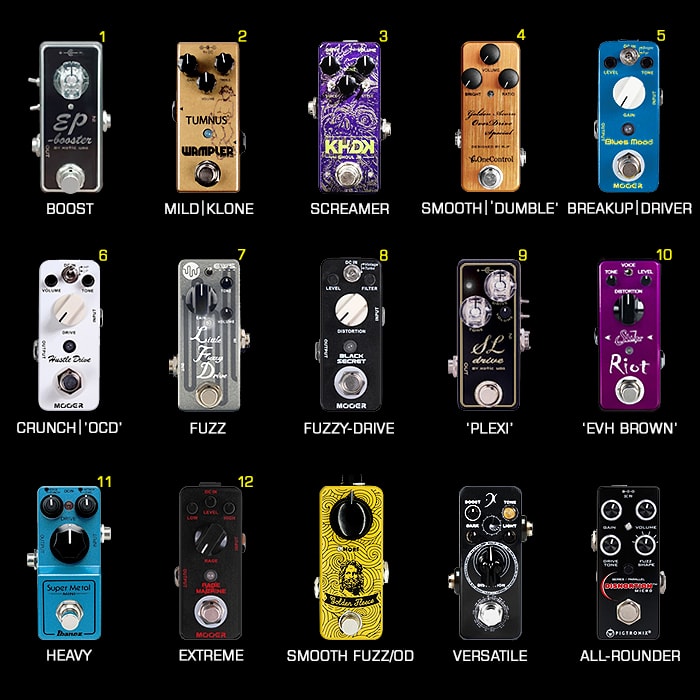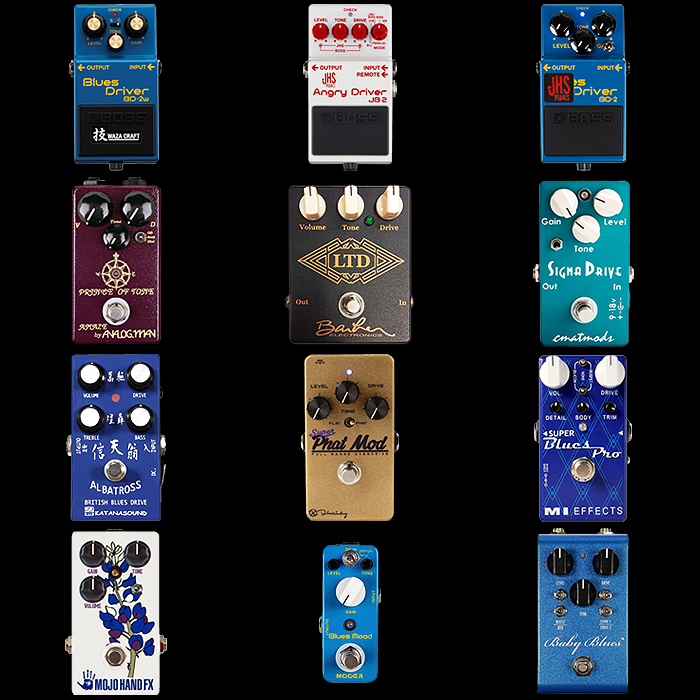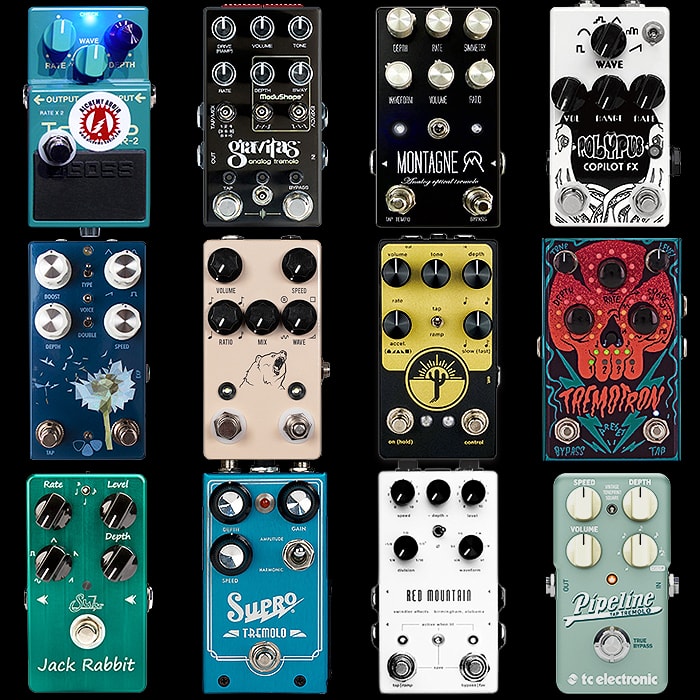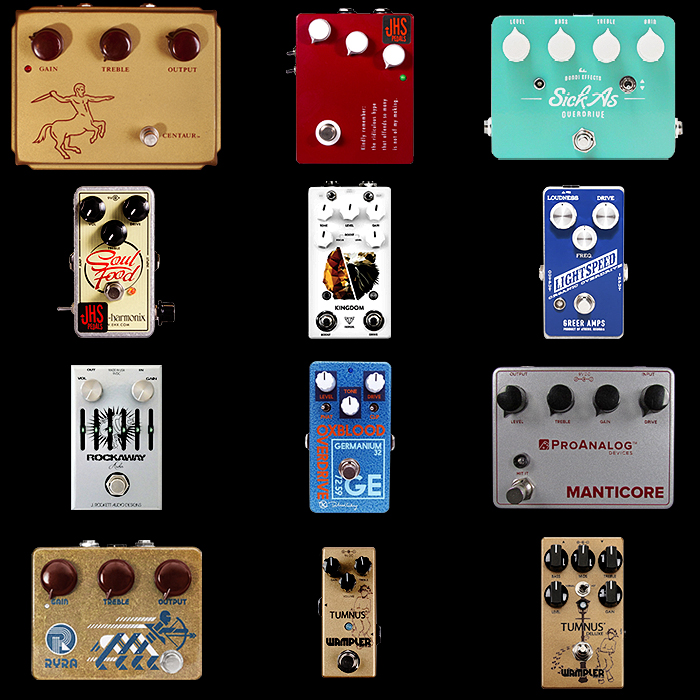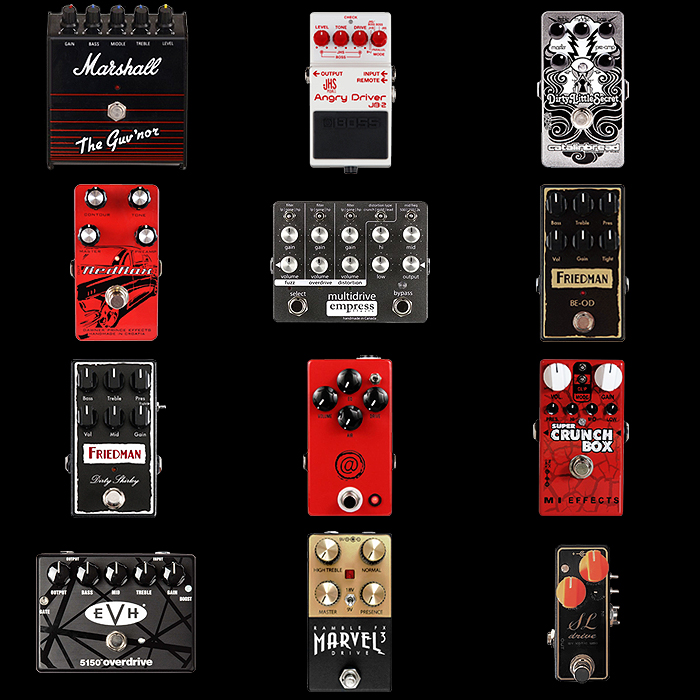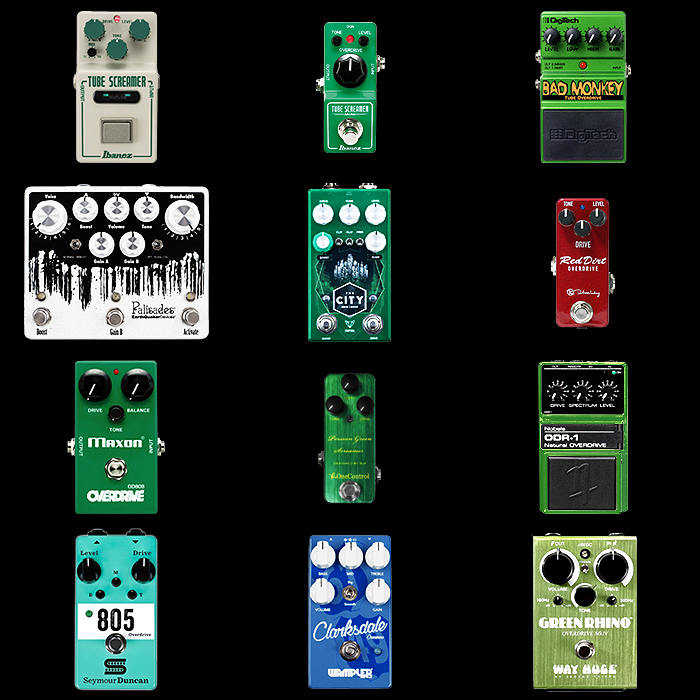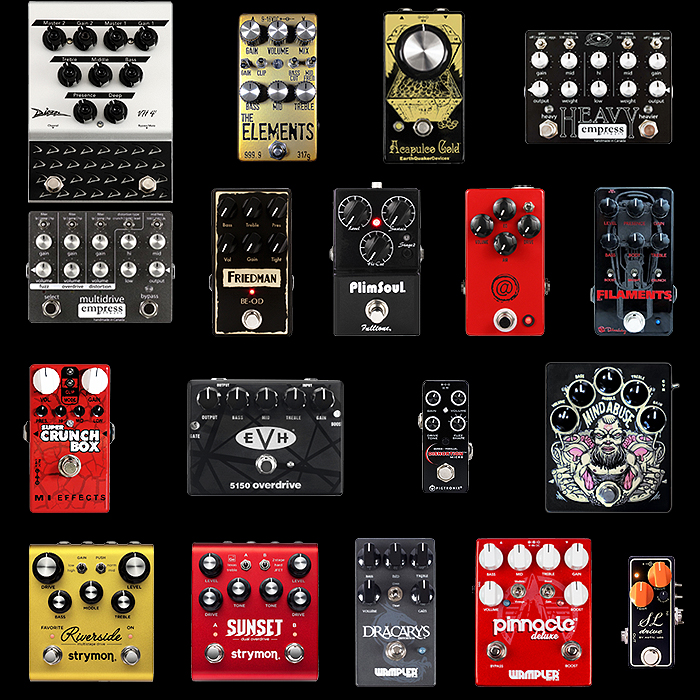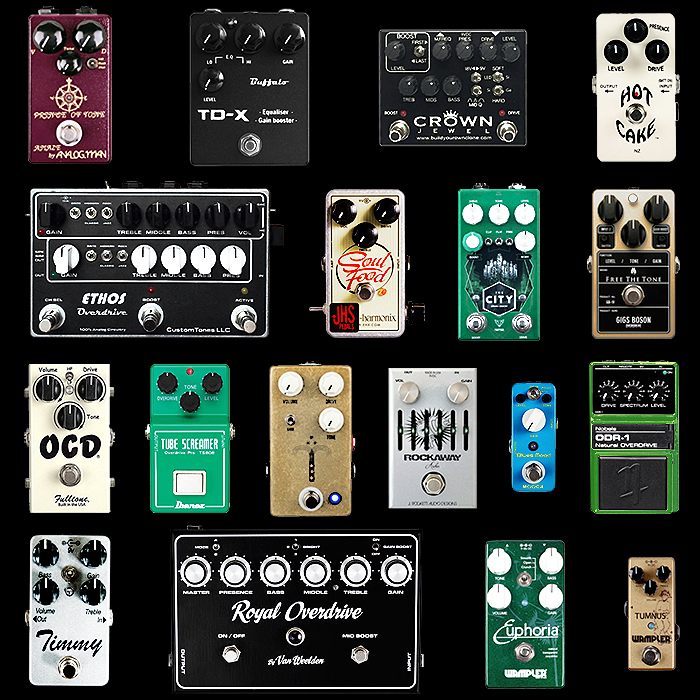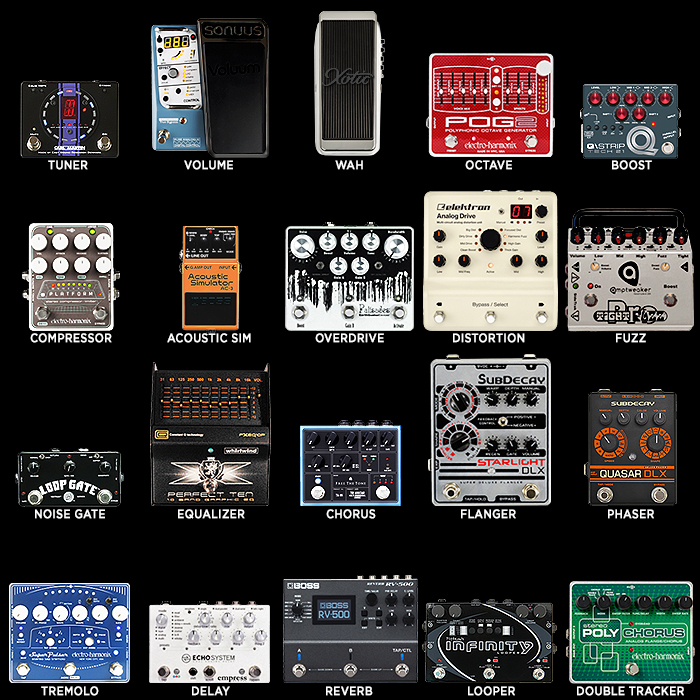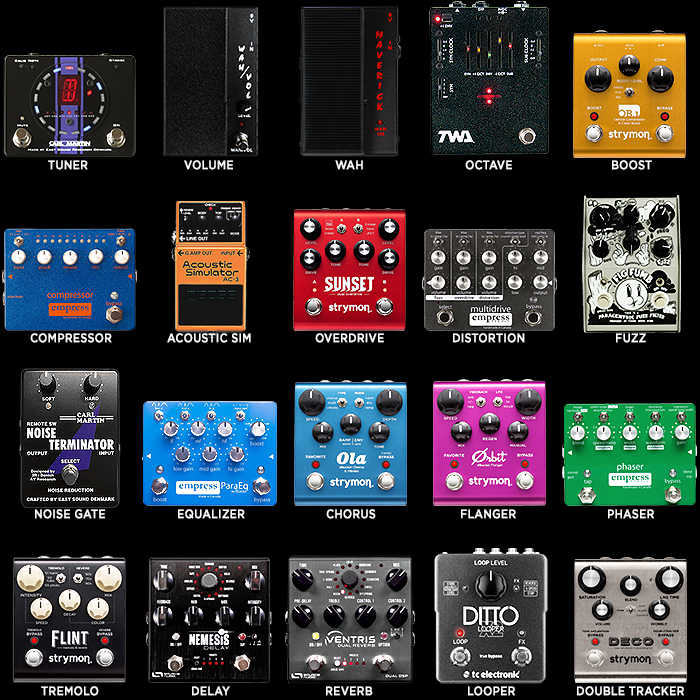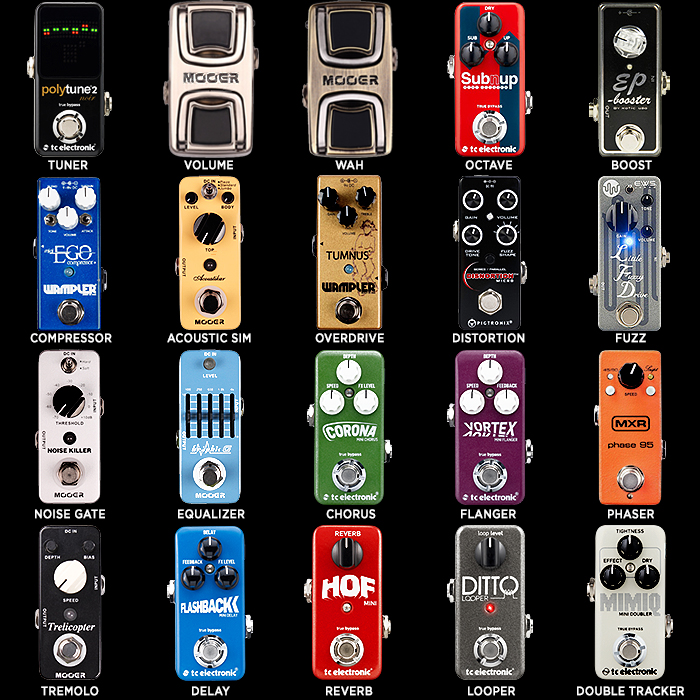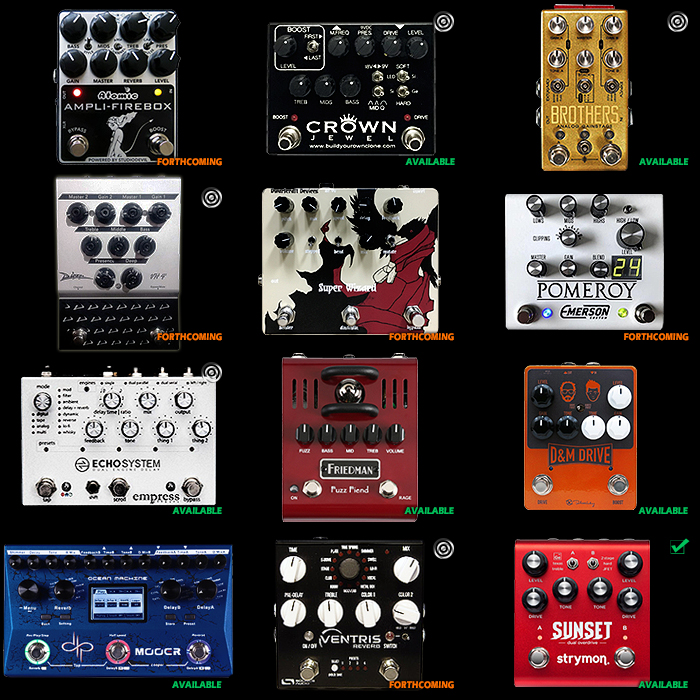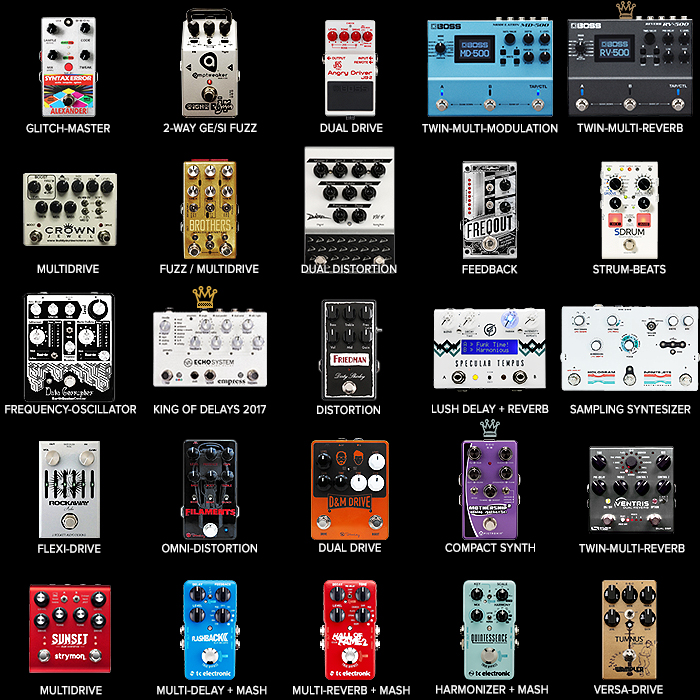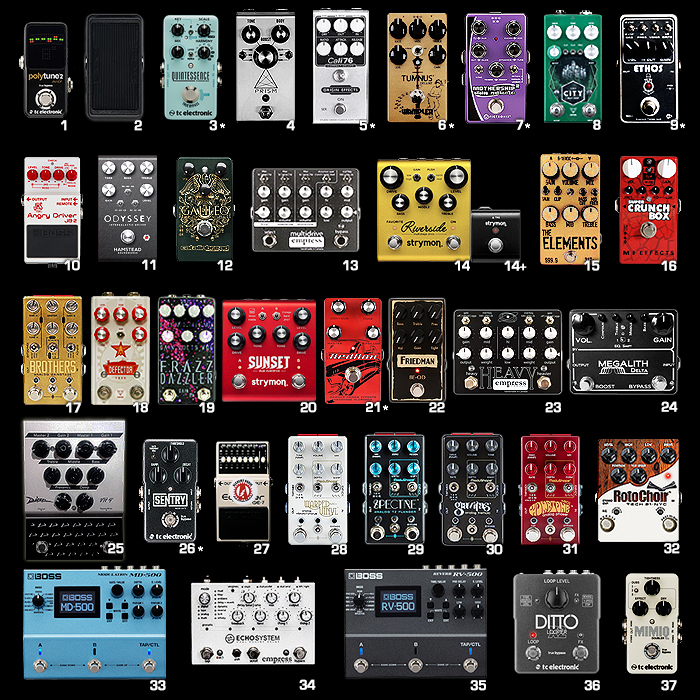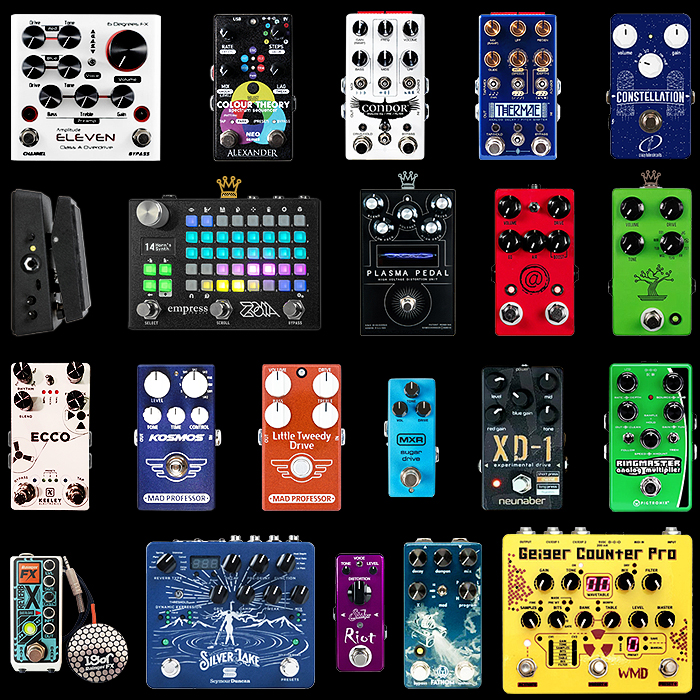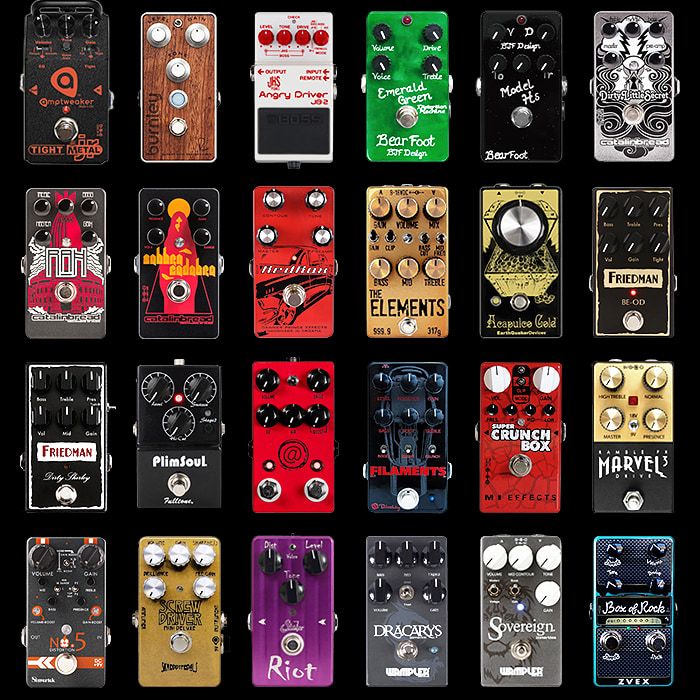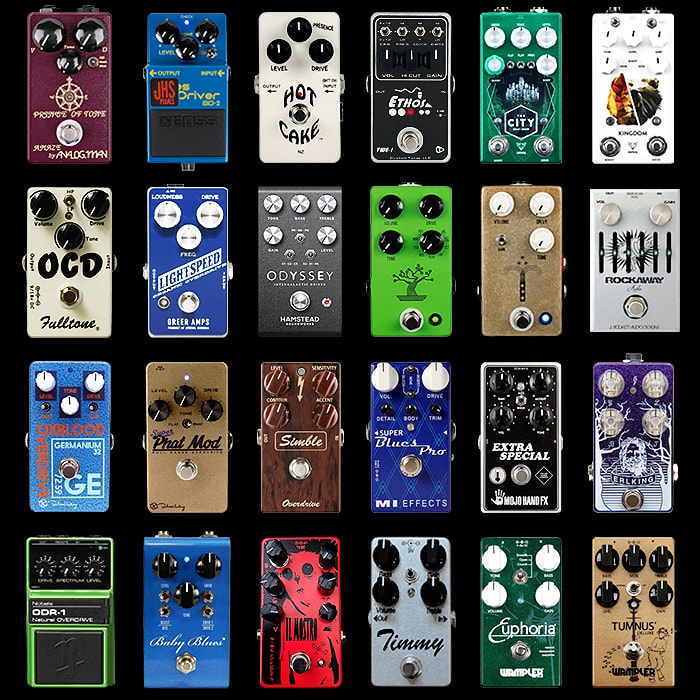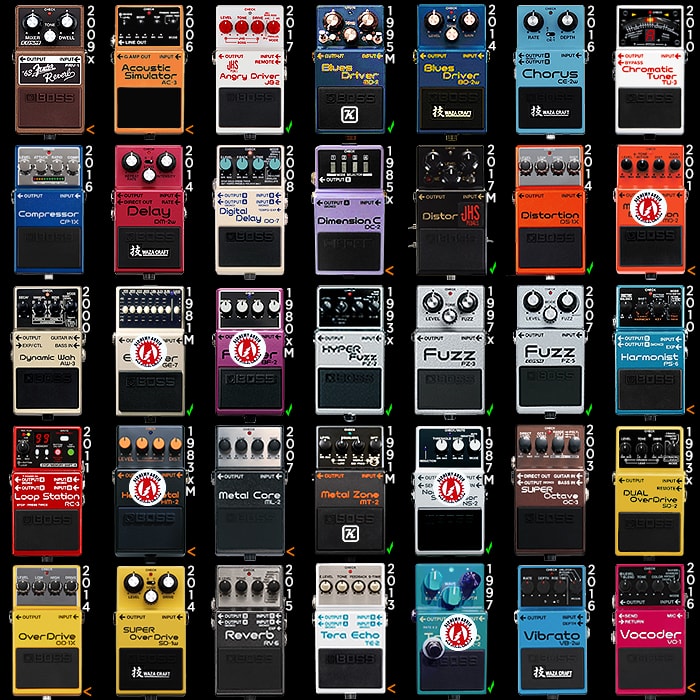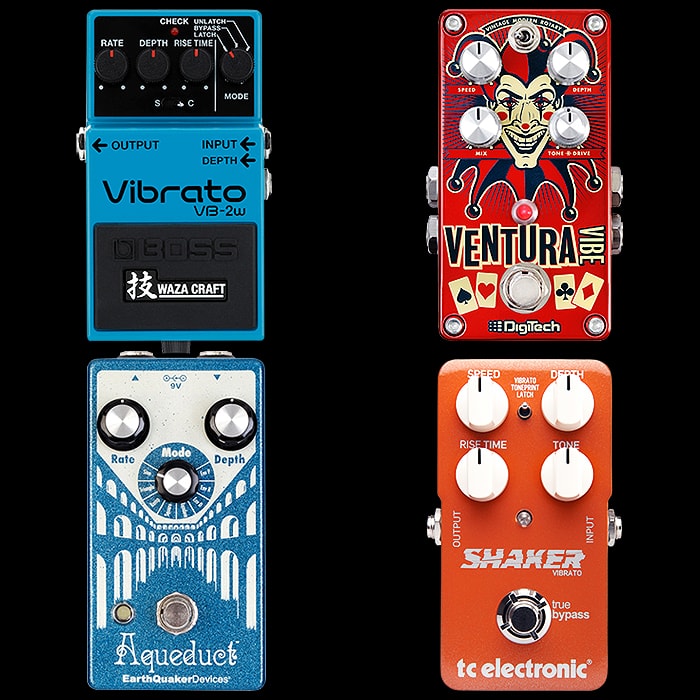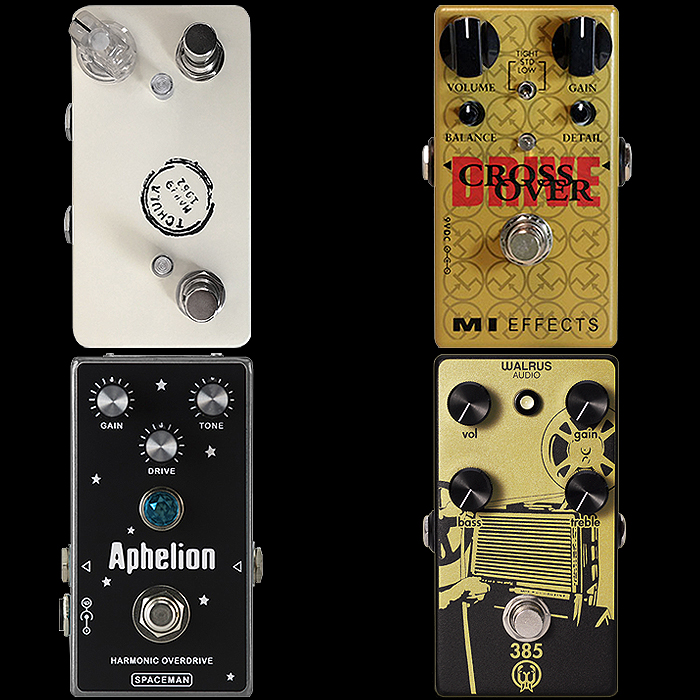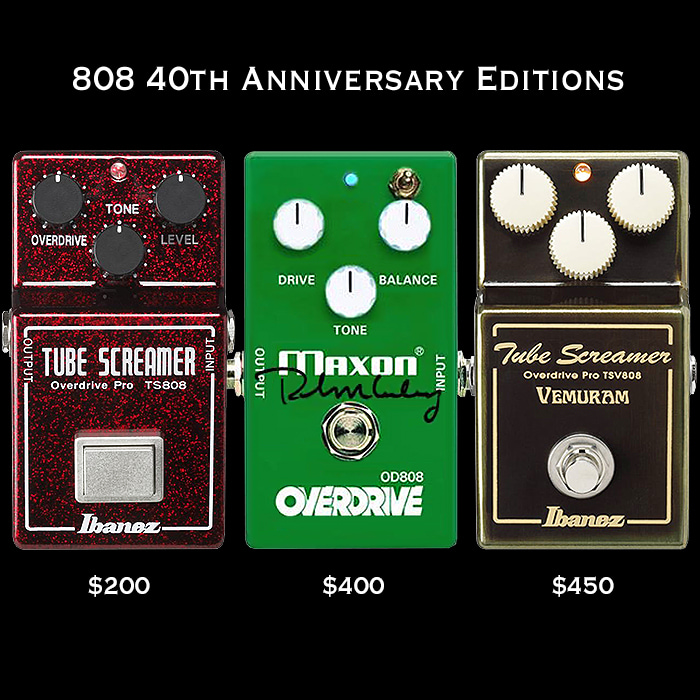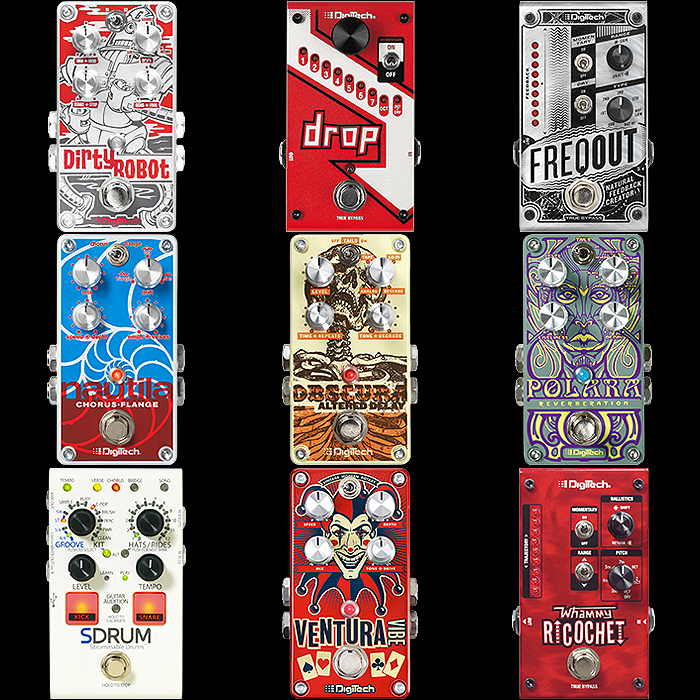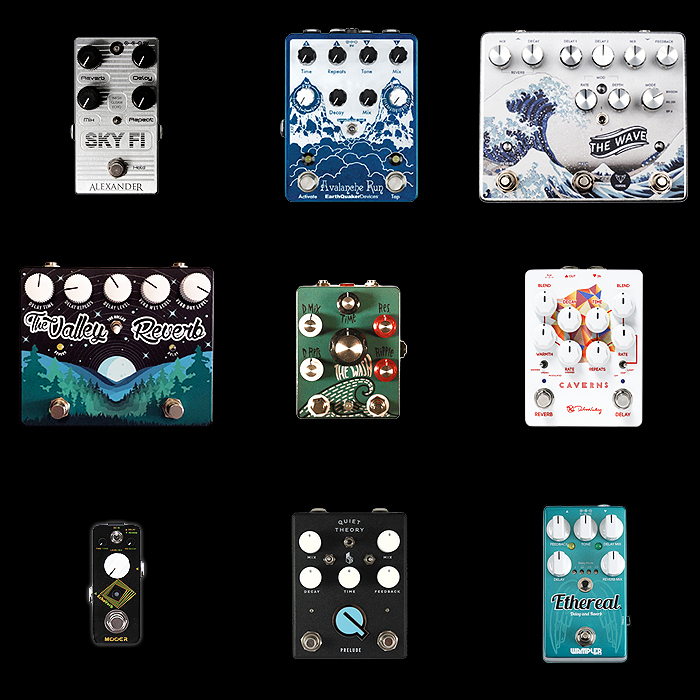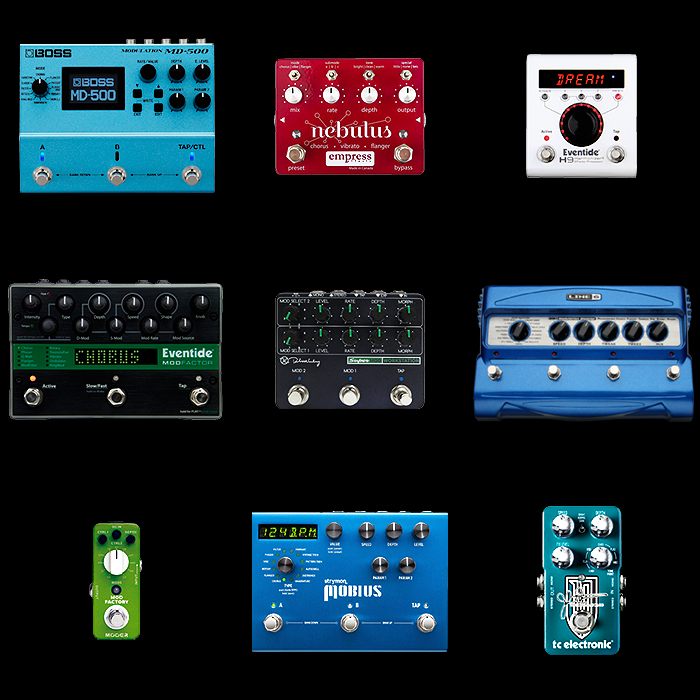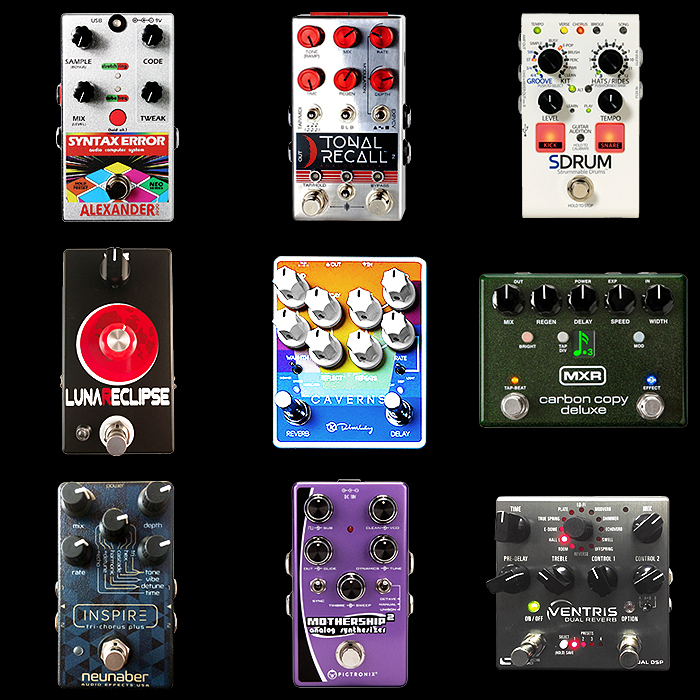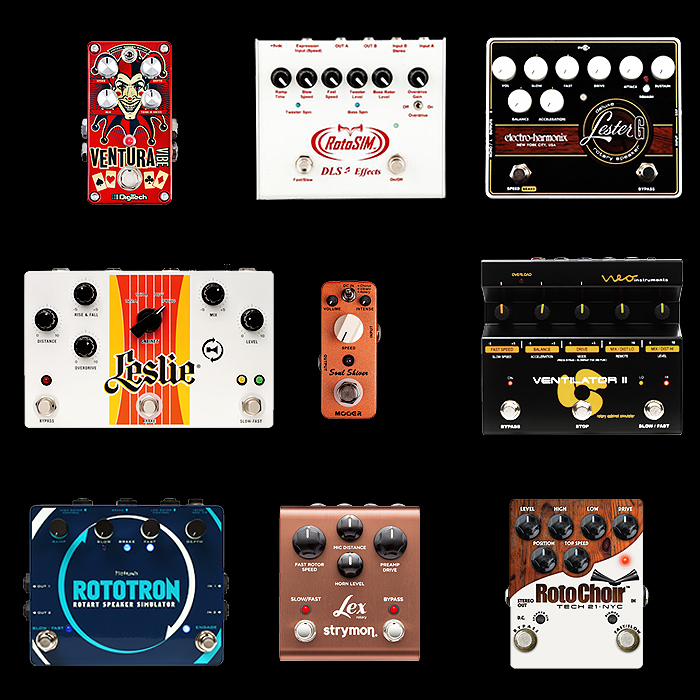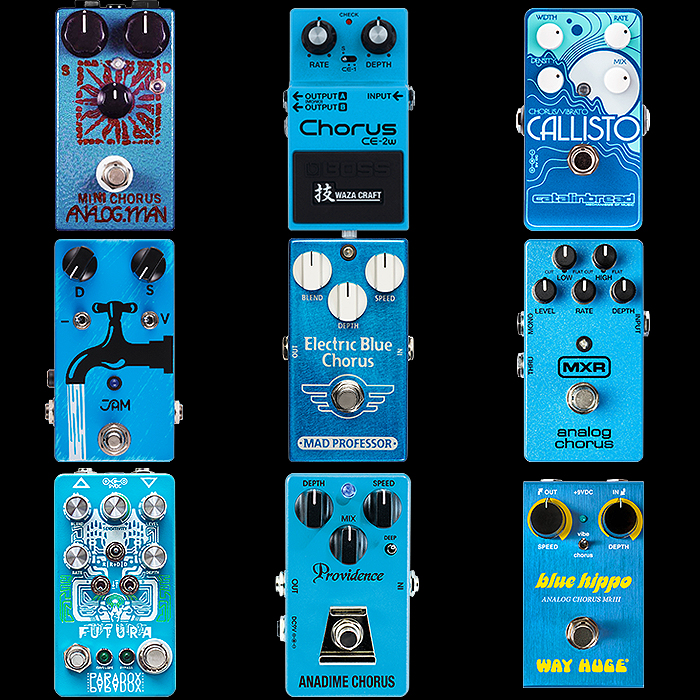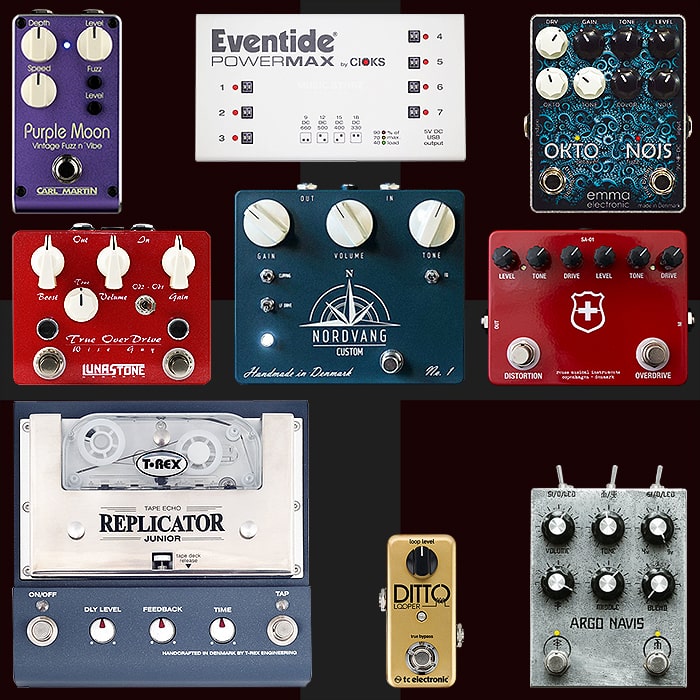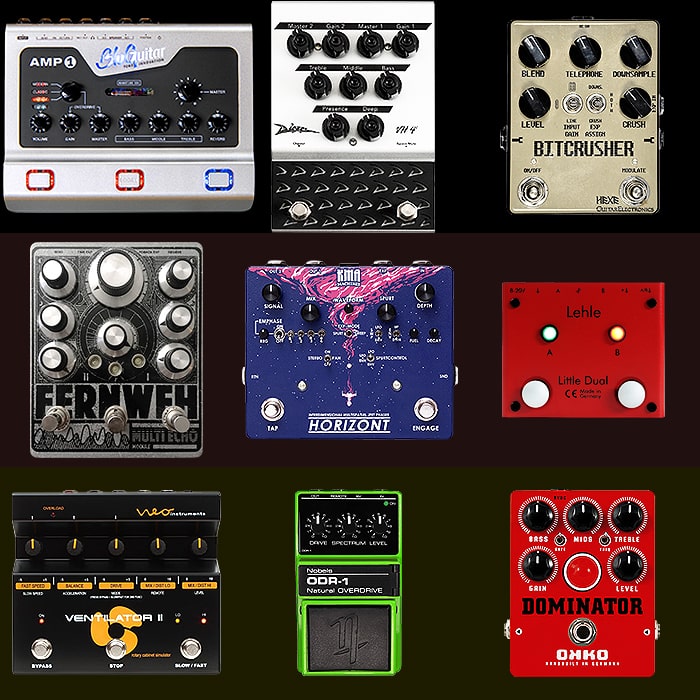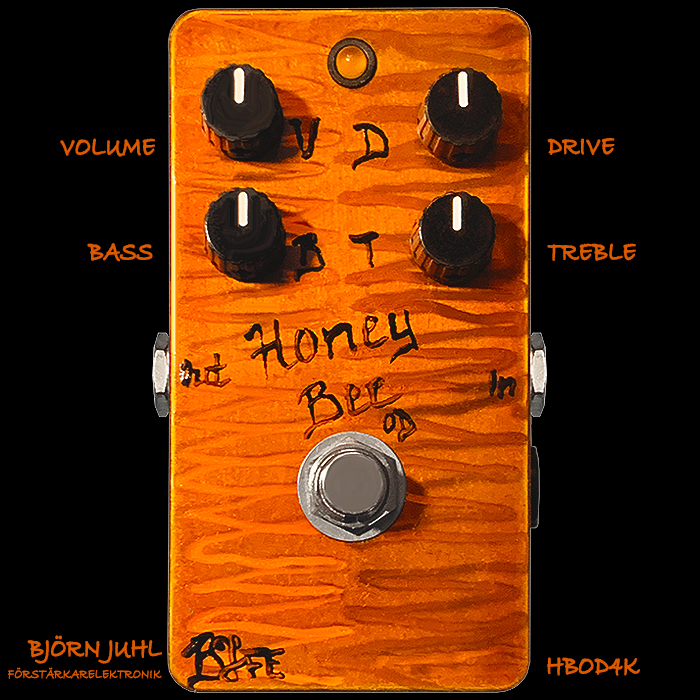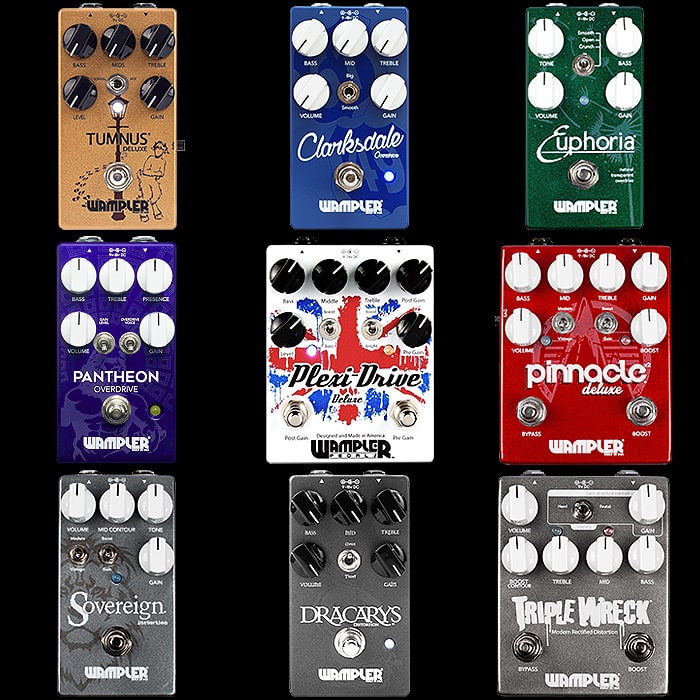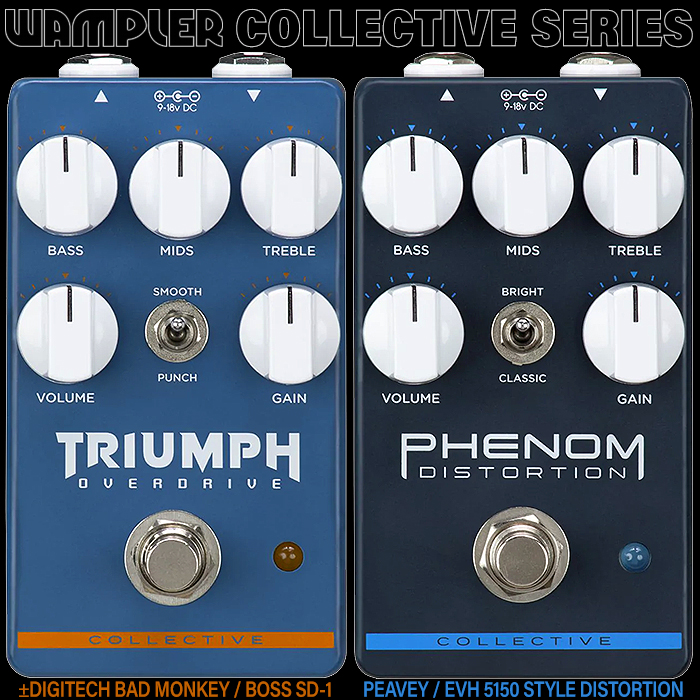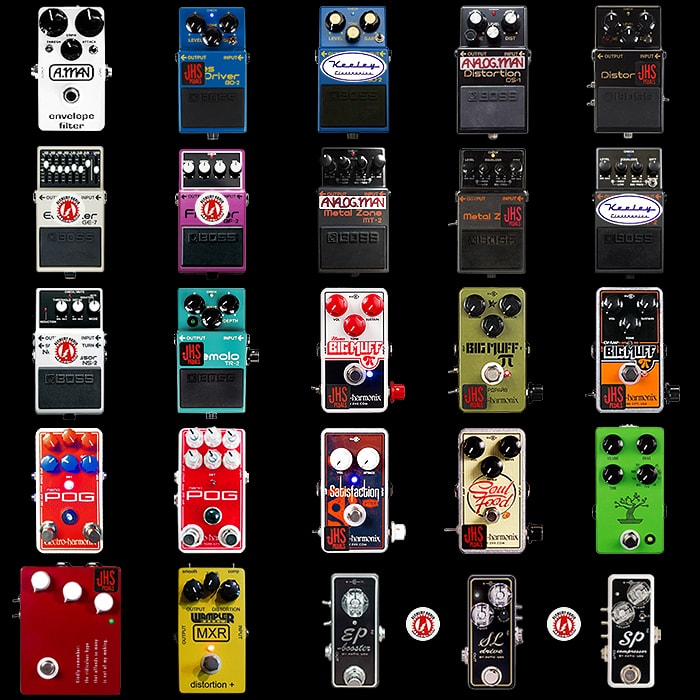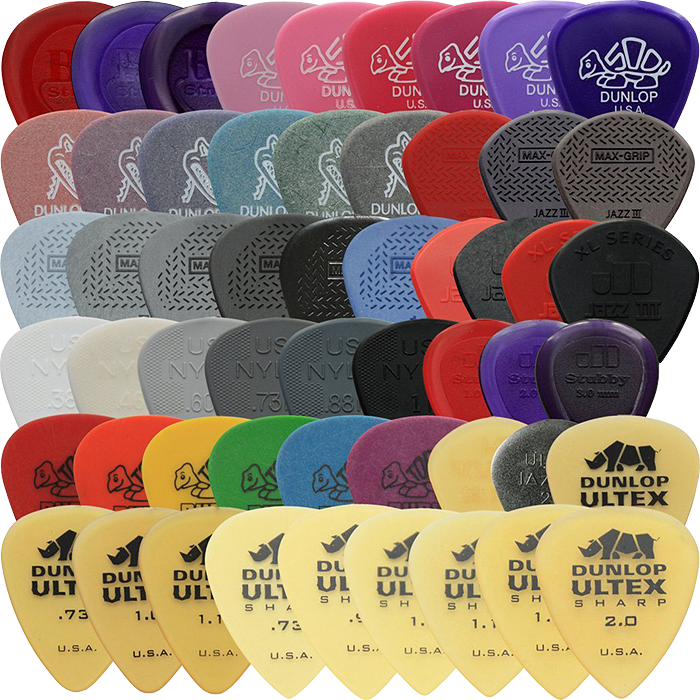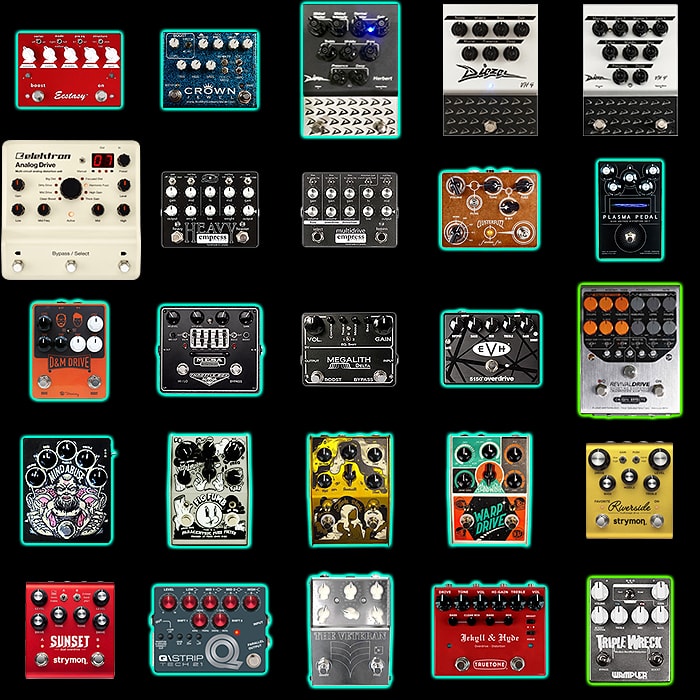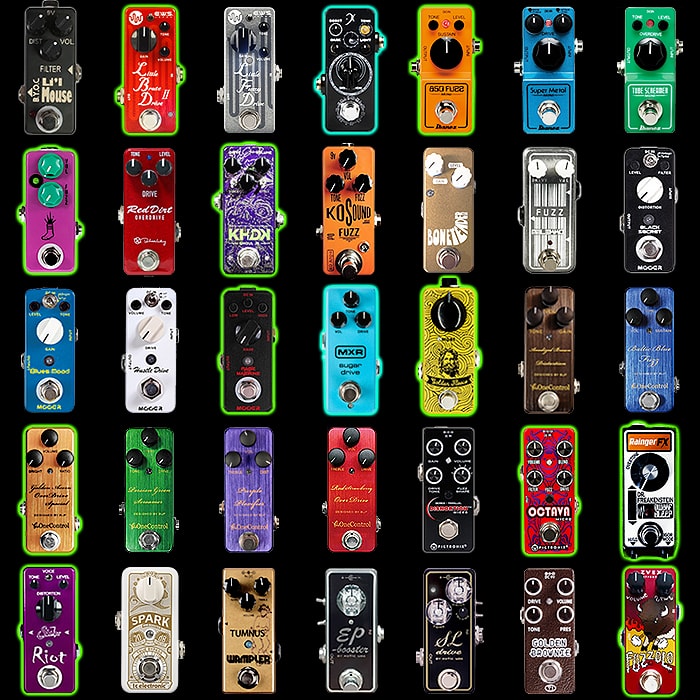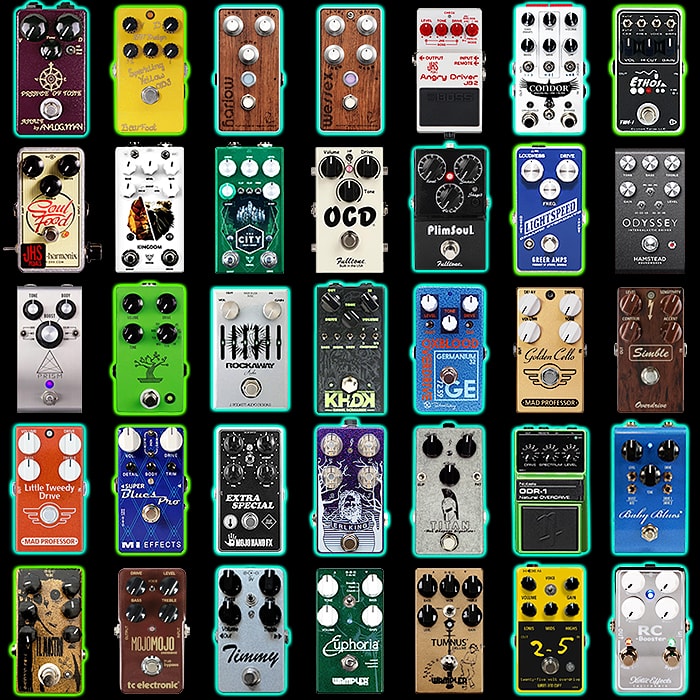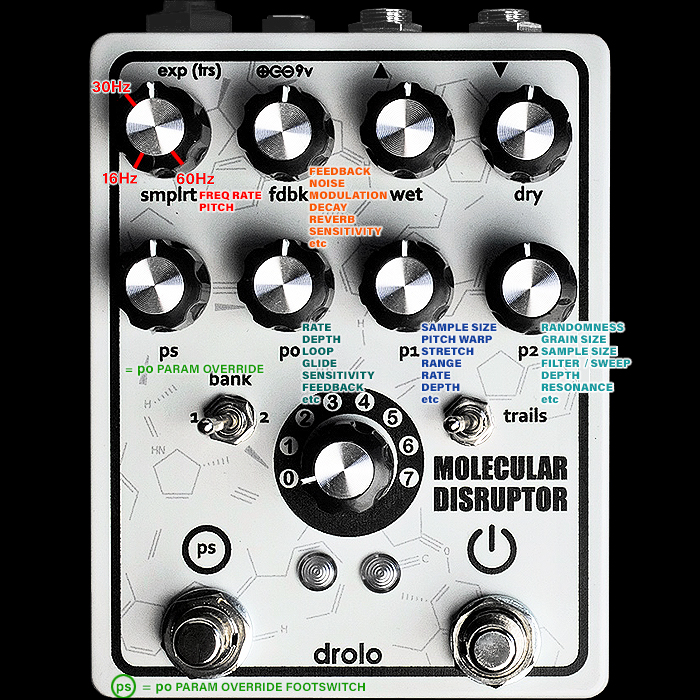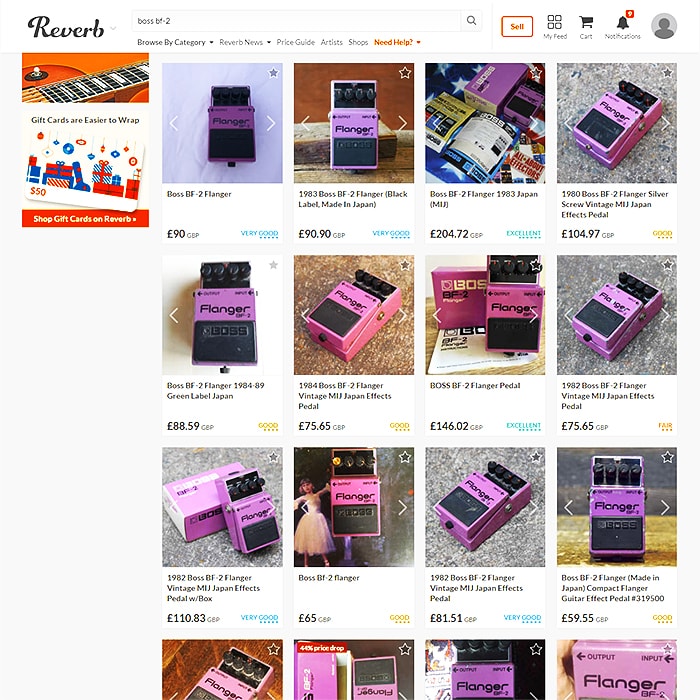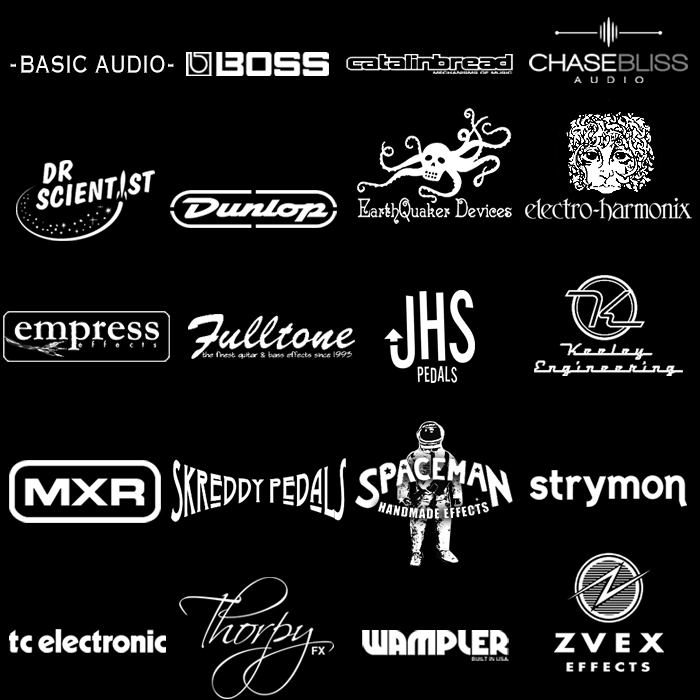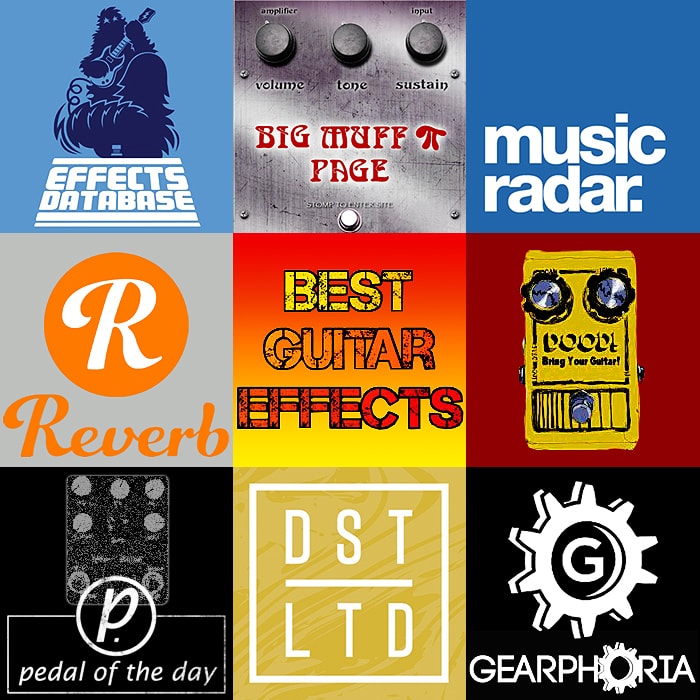Guitar Pedalology
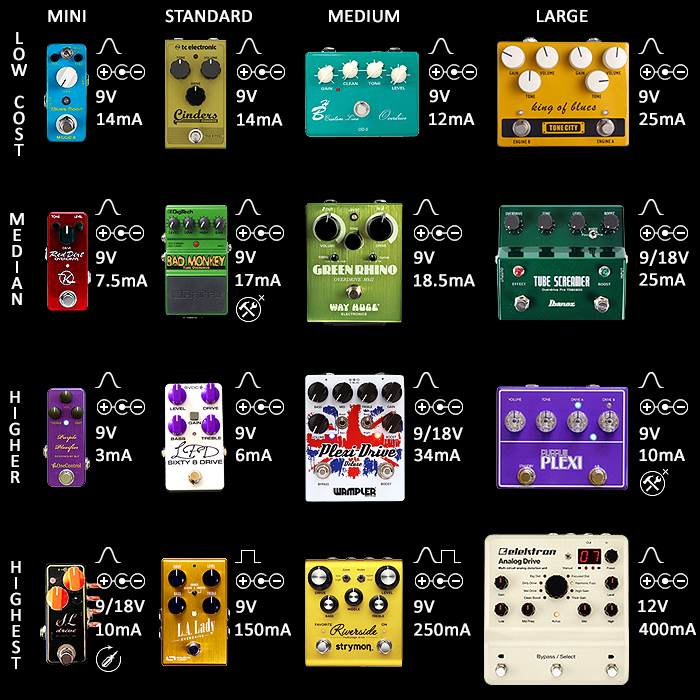
Or - everything I did not know about Pedals when I got back into guitar.
You may recall from my ’Tone Anxiety’ blog post that I listed a few hundred pedal manufacturers and mentioned that they were just a drop in the ocean - well, it turns out to be a darn sight more complicated than that. Not only do you have hundreds of these pedal makers, often just one guy in their workshop - in pretty much every country in the world, you also have a huge second-hand market of current and older vintage / collectable pedals, as well as DIY Kits, clones and duplicates as well as various modified versions.
The above visual identifies a plethora of different Overdrive and Distortion pedals within 4 key categories. Overdrive / Distortion pedals are by far the most numerous pedal type - there are literally hundreds in all shapes and size and with variable degrees of versatility. Most serious guitar buffs own probably as many as 20 or more of this type. I believe I am not far off that number myself - 6 of the pedals pictured are in my collection already.
You can see by legend what some of the key specs are for each pedal - Analogue / Digital or Combinations, Power requirement and current consumption, as well as icons to indicated discontinued and modded models!
Size / Footprint
At the starting point, it must be pointed out that there are essentially 4 main sizes of pedals available. The ’Standard’ size as per most everyday Boss and MXR workhorse pedals are around 7cm wide, with mini pedals being just over half that - say 4cm - which we will call 1U. So in ascending order of size you have mini pedals at 1U, standard at 2U, medium at circa 4U and large ones at 6U and above - dimensions can vary a lot, especially pedal length and depth.
The key dimension though is the width, as this is what largely determines the size of pedalboard or necessary useable floor surface area. There used to be a time when mini pedals were almost entirely low cost alternatives to standard sized ones, but in recent years pedal manufacture is increasingly polarising to higher quality mini pedals and extensive full-range workstation larger pedals. Both MXR and Ibanez have relatively recently brought out great mini versions of some of their classic pedals, strangely Boss is not really picking up on this trend yet.
Pedal size no longer equates to quality, but usually restricts the versatility and functional range of such pedals. You need to consider what your usage scenario is here, and other factors such as cost and cable access - not to mention the oft-times fiddliness of manipulating tiny toggles or having to access pedal innards to flip dip-switches!
Top-loading vs Side-loading
We’ve mentioned how critical the width dimension often is with pedals, so in recent years, pedal makers have increasingly started placing cable sockets along the top face of the pedal, as side-loading pedals will of course need several additional cms of width to accommodate cable terminals.
Smaller / mini pedals almost always have their cable sockets on the side. as there is insufficient surface area to accommodate power supply lead as well as in and out cables on the top face.
If you can though, it is normally in your best interests to choose top-loaders as the pedals can then be placed much closer together on the pedalboard - so you can fit more in.
Pricing
Currently the floor level price is around £40 a pedal (mini typically) - for Chinese brands like Joyo, Tone City, Mooer, the lower cost TC Electronic Line etc. Note that there is a lot of contract manufacture here too, which means essentially the exact same pedals appearing in very slightly different enclosures. (Moval vs Tone City, Mooer vs Xvive etc.)
The lower end is really around £40-£65 per regular affordable pedal. Above this you then have the industry standard Boss and MXR pedals at around £70-£100 each.
Next is the kind of high quality mid market - like Japanese mini pedal brand One Control - who make amazing pedals at the £100-£190 mark. DigiTech mostly operates around this level, as does Electro-Harmonix.
At around £180 you are then into the domain of the boutique pedal. Both my mini Wamplers - Mini Ego and Tumnus are around £180, and Wampler is a good reference point with pricing mostly around £180 - £280. Note that certain boutique mini pedals - like Xotic can be found at a relatively reasonable £140-£160 too.
Up from this you are into mini workstation territory - pedals that convey several functions. Most of the Medium Strymon pedals are at £299, with the 3 current larger units at around £429 to £479.
Further up from this then you get more elaborate hand-made units - like the Van Weelden Royal Overdrive at £599 for instance, or the T-Rex Replicator at £649 - while the very imminent T-Rex Binson Echorec will likely be north of £1,000.
As with anything, you need to evaluate quality vs price. Here we don’t just mean sound quality, as many of the cheaper pedals can sound amazing. However - to produce pedals at that affordable level, you must make concessions in the manufacturing process which almost always means use of cheaper and in some way inferior components which will like affect the lifespan of the pedal also.
In my signal chain I have really just one budget pedal so far - the Mooer Blues Mood, but there are several more Mooer, Eno and Tone City ones I quite like the look / sound of and which I may acquire later. All those pedals are at the £40 to £60 mark.
Generally I would prefer to pay a little more - say £100+ for a One Control pedal equivalent to ensure a better quality of components. There is also the option to buy cheaper pedals and have them modified / upgraded.
Mods
Several pedal makers - including Josh Scott of JHS and Robert Keeley of Keeley Electronics - started off as pedal modders. Buying stock pedals and improving them by switching out and/or adding components. All the Boss Pedals for instance are great value at around £70, but for whatever reason they feature a slew of cheaper and inferior parts which give you unwanted noise, lower range of output and overall less fidelity than is routinely possible.
I’m a big fan of Chicago native Johnny Balmer - of Alchemy Audio - who provides both modding services and already-upgraded pedals. He tends to prefer buying lightly used pedals and cleaning them up and upgrading all the cheaper components with higher quality alternatives. He also improves the various Xotic mini pedals by upgrading the interior dip switches to exterior toggles - meaning you no longer need to screw off the base to sculpt your tone!
You can buy and send your own pedals for a service or ask Johnny if he would consider upgrading type-X for you. I really love my mini Mooer Blues Mood, but am sure Johnny could give it more fidelity and greater longevity with a few basic mods.
Several mods are so successful that they end up coming back around into the official version of the original pedal. More often though it’s not just a question of what pedal you’re getting and at which particular size, but which specific modded version of you are after. Several pedal makers continue to sell modded versions of other manufacturer’s pedals - they are pretty much all available on Reverb, and some even filter through to official retail channels like the JHS modded Electro-Harmonic Soul Food - which is available at Andertons.
Compatibility
Compatibility here does not mean power requirements / cabling etc, more of that later. Here we are talking about how well the pedal will complement your existing signal chain, pickups and amps. Certain pedals need just humbuckers or single coil pickups to sound truly fantastic, some don’t work well with digital / solid state amps, and others don’t play particularly nice with tubes.
There are various means at your disposal for dealing with such issues - use of Compressors, Noise Gates and EQs. as well as routing pedals into separate loops or sending directly into the power amp - via the amp’s fx loop.
Yet with all these considerations and workarounds, there will still be instances when pedals are just ’meh’ with your particular setup. It is rare that a pedal will sound crap - you usually just need to spend enough time dialling in the appropriate tone/s. Yet even with an optimized tone for a particular pedal, it may be somewhat ill suited for your particular setup.
I spend so much time on research before I buy a pedal that I have yet to officially come across a total dud. You can’t really test the pedal in the store though - you need a couple of days with your own specific setup to ascertain how viable a pedal is for you and how well it will work. Some pedals are of course more forgiving than others and can sound amazing on almost anything. Be sure though that you do sufficient due diligence to know exactly what it is that your pedal provides - so that it will more likely meet your expectations. As you will read in a future post - there are literally dozens of different types and levels of distortion, and no one will like all of them - some pedal use rare, old-fashioned components which deliberately leak noise of have some synergistic aspect that yields unique and unusual tones.
For overdrives and distortions, many pedals cannot be adequately replicated digitally - they need the organic components to be able to deliver that unique timbre of tone which makes tube-driven tones sound so special.
Second-Hand!
As mentioned at the start, there is a huge market for used pedals - I would warrant that well over half of all sales on Reverb.com are for pedals - and a large part of those have had previous owners.
Pedals are largely but not entirely solid state - some of the older tube-based ones are obviously highly fragile. Newer steel enclosed ones are generally built like tanks though and should be good for a few years. The exception is for Wah and Expression / Volume pedals which use mechanical pots. You may be better of in those cases to go for more optically-based pedals - which have far fewer wearing parts and a lot less problems. Most of the mechanical pedals can suffer from various difficult-to-diagnose issues and should be steered well clear of really - unless you are willing to do your own maintenance.
Everything else though is fair game, and you can often get a real bargain this way. If the price is that good, you can always send it on to Johnny at Alchemy for a service, and he should be able to ensure a good many years worth of use out of your pedal.
Both the modded Boss pedals I have thus far acquired from Alchemy Audio are refurbished and upgraded lightly used pedals. Johnny does have several new ones, he also assembles various kit format pedals - like the BYOC range of mostly clones - which generally use the exact same circuits and components as their original inspirations.
You can often get the equivalent of an industry standard pedal with enhanced features and/or in an improved form factor - for less than the original. For instance the BYOC Li’l Mouse pedal faithfully recreates the ProCo Rat circuit in a mini pedal, where the original is a good 4 or 5 times that size.
Power Requirements
Pretty much all contemporary pedals are either 9V, 12V or 18V DC current. The vast majority are 9V and require centre-negative power supply plugs. Older ones can be battery only, centre-positive and even AC current - so you need to be very careful when plugging in older pedals.
Most manufacturers are woefully poor at referencing Power requirements - i.e. Current Draw - which can vary from below 10mA (milliamps) to over 500mA. The vast majority of the 9V are under a 100mA - probably 90% are under 25mA.
You can buy a single One Spot 1700mA power supply - which comes with an 8 plug daisychain - meaning each pedal can average 200mA or more. For more elaborate signal chains you need properly insulated and isolated power supplies like the Strymon Ojai and Zuma. I use the former to power my 4 Strymon pedals, and the 5th socket is daisy-chained to provide supply to 6 or 8 further pedals.
I have a large 12V Diezel and even larger 12V Elektron pedal - both of which come with their own power leads. At some stage in the future I will acquire a Strymon Zuma to tidy this up a touch.
You really need to sit down though with a pen and paper and reference to the following site - stinkfoot.se/power-list - where most manufacturers are listed out. I really don’t understand why Boss and Ibanez for instance are so poor at giving you these essential details - some of the manuals don’t even reference the current draw. The cleverest pedal makers print the mA details next to the power socket on the device - the worst, don’t even include the details in the manual!
Cables, Loops and Troubleshooting
Using pedals inevitably brings you into patch cables and cable management. If you have a switching pedal with loops, as opposed to a looper, you can set up mini groups / chains of pedals which work well together. I in my madness though heed none of this - as I have a long signal chain of more than 20 pedals.
If you are going to run long chains / loops, then diligence is essential, as things quickly escalate and become unmanageable. When you have a long chain of pedals - if something goes wrong somewhere along the chain, it is very difficult to troubleshoot. I in fact have two loops within the same chain - all the heavier overdrive and distortion pedals are on the secondary GE-7 Noise Gate Loop, while the less noisy pedals go through the ’clean’ loop. So I can more easily find potential troublemakers.
Once you have a clever switching pedal with multiple loops, several loops can drop out of use, while the signal is still maintained, so this is definitely the way to go.
Much like different sized pedals - their arrangement and footprint, you do a similar exercise with cables based on their required length and proximity. About 90% of my patch cables are 6" Fender Performance Series, I also use a smattering of Hosa 12" cables which look similar but are slightly skinnier, as well as some Planet Waves Classic and Custom 3 and 5 feet cables - those kind of cover all basis for me.
I’ve had a couple of issues with signal interruption where power leads weren’t plugged in on buffered pedals, or where cables weren’t fully inserted into pedals - these were both quick and easy to troubleshoot.
Use high quality cables to minimise noise and signal bleed. If you have a really long chain, some slight noise is inevitable - even with noise gates and EQ - that is why you are better of splitting your pedals into separate and more manageable loops - of course it does not help that I’m currently using 14+ different overdrive, fuzz and distortion pedals - but they sound great!
It seems a mental state also on occasion as sometimes your chain sounds lackluster while at other times you think it sounds amazing with the exact same settings. There may be other variables at play here, but I put this largely down to tiredness, temperament and mindstate. Invariably and after a good night’s rest it all sounds amazing again the following day ...
Dialling in Optimal Tones
I have mentioned elsewhere in this piece - the need to be patient in arriving at your optimal sound. You need to be careful how you set up your amp, your guitar - pickup selector, tone and volume knobs. Never have everything set to 10, as you’ve only got one way to go from there. If you notch everything down 2 or 3 clicks or equivalent, you retain sufficient degree of sound sculpting to maintain optimum tones across different scenarios - different pickups selected, pedals with slightly different gain levels, brightness etc.
Once you arrive at a great sound - make sure you make a record of those values as it’s not always easy to get back to where you were - your ears are not always consistently sharp and various other factors can affect results. Be patient, take your time and know and document what you do - there’s nothing more frustrating than trying to get back to some mythical moment you though you had but you can’t seem to get exactly the same dynamic tone that inspired your previously - this is often just tiredness - take a break, take a nap and come back to if later in a refreshed and reinvigorated state of mind.
Never forget the pickup selector either - occasionally I’ve been tweaking for a long time trying to arrive at a revered place, but have inadvertently slotted the selector into bridge pickup setting rather than the neck pickup which I usually prefer.
Dry vs Wet Signal / True Bypass / Buffered
You will hear people talk a lot about dry and wet signal - this means splitting out the signal into the original and unadulterated direct guitar output and the effected signal or processed output. The former is known as Dry and the latter is Wet. It is widely agreed to be advantageous to separate these out so you can vary the mix, as well as have more control over shaping the tone of both elements without suffering undue noise artifacts, feedback etc. With dual amp setups you can send the Dry signal to one amp and the Wet to another.
A True Bypass switch on a pedal passes on the signal wholly untouched when the pedal is off - preserving the quality of the signal, While buffered is an artificially stimulated or boosted / supported output for instance used to maintain the tails of a decaying effect when you switch the pedal off - so you don’t get a sharp drop off in sound, but that fx element fades out gracefully and elegantly.
There are numerous uses for buffering - to help control and maintain signal quality in other ways. Some musicians complain of ’signal colouring’, as buffering can cause a degree of compression, sound-smoothing or other possibly unwanted artifacts - there are pros and cons for every approach of course.
Analogue vs Digital
Traditional pedals are usually analogue, while more modern ones tend to use some degree of digital - as with everything else on this page both have reasons for and against and definite best practice uses. You generally get better tones with analogue, but digital is more versatile and can do a lot more, so the most capable pedals make use of both elements as well as a Wet / Dry split. You will read lots about pedals maintaining the analogue signal / AKA dry signal, but using digital for advanced and additional functions like managing presets and midi manipulation.
When it comes to Overdrive and Distortion, to my ears you simply have to have analogue. Digital works amazingly well for ambient signal processing and modulation, as is borne out by the quite superb studio grade trio of pedals - Mobius, TimeLine and BigSky. For my taste though, the Strymon Riverside made too many concessions to digital processing, which means that the output ends up being just a little too clean for my taste. This is probably part and parcel of their ’Infinite Sweetspot’ algorithm which works to optimise the output gradually and seamlessly right through the full spectrum and transitions of 4 progressive gain stages. So there is some serious processing magic happening, and I do genuinely love the pedal, but it is missing ’dirt’ or ’grit’ and could do with additional parameter controls like tightness and fatness.
So in short - I’m happy to have my delay, reverb, tremolo etc. as digital, but insist on analogue gain stages for overdrives, fuzz and distortion.
Apps / Tone Cloud / Toneprint
In my second guitar rebirth I made the horrendous mistake of buying a Line 6 Amplifi amp which I just could not get to work properly. It had so much of its functionality reliant on a blue-tooth App - that it reduced the actual amp to a dumb box. I had all manner of problems with connectivity and accessing and downloading chosen tones as well as trying to update and reset the firmware - it was so unbearably frustrating that I send it back within 24 hours.
I decided at that point that all my guitar devices would and could operate fully autonomously - with all the functionality fully backed-in and accessible through the actual physical box - this is why I love Strymon so much.
I have a few TC Electronic Pedals, but have not dipped my toes into their Toneprint-enabled ones - which are mostly modulation / delay and reverb which I use my Strymons for. Same goes for the excellent Source Audio La Lady Overdrive - which allows you to do all manner of clever things via an app. But again too many of those essential controls are not on the box, and you become overly reliant on connective technology which has all manner of associative problems. Moreover, I would like the Toneprint technology more if those pedals had a number of onboard presets that you could toggle between on the actual devices - far too many of these require unnecessary tweaking and tinkering.
So from a personal perspective and all the reasons given above - I still largely steer clear of these, although I can see their appeal to others.
Headroom
This is a word you will come across a lot in reference to amp and pedal output. A great reference point is headphones actually - which largely have very little headroom or proper ambience - many tend to sound thin and somewhat two-dimensional. With fuller or added headroom you break out into a more 3D and vibrant soundscape which renders notes and tones at far higher fidelity and the sound has more detail, depth and thickness to it.
In the pedal world this usually means applying higher voltage power supplies to the pedals to produce a more enhanced ambience - so that your guitar expression, touch and feel can attain the very highest level of what is possible. I have several pedals - some indicated in the above visual which have options for 9V or 18V supply. On occasion you may prefer the resulting 9V output as you can get some interesting compression and colouration vs the greater separation, clarity and musical delivery of notes at higher voltage and headroom levels.
Currently I have two pedals at 12V, and I use a voltage doubler on the Xotic SL Drive, as this improves its sound for me, while I found that upping the equivalent compressor to 18V had a negligible or possibly even diminished effect.
Level / Output
Not all pedals are created equal - some have a lot more headroom / output than others. This means you have to ’tune’ your signal chain to the one with the lowest level. This can make things difficult if you have already established unity / parity across the chain, and then try to introduce a new pedal which outputs a lot lower than the others. There are ways around this - by adding an additional booster, but you may decide that said pedal might just be incompatible with your chain / board. If you genuinely love the output you may have to set that level as the reference - and then tune all the other pedals to that lower output - in order to achieve parity.
Unity
This is ensuring that each pedal output level matches that of the entire signal chain - so you don’t get weird spikes in volume when switching between pedals. This can mean both rises to volume, as well as dips. It is essential to tune the whole chain output to the volume of the least powerful pedal, and you can make up the different with the amp master volume. You may need a decibel meter to ensure you have parity right along your chain. There can of course be exceptions - say you use a specific pedal for solo elements, this can therefore be standard dialled in a little louder. For seamless and fluid playing though it’s generally advised that you try to maintain unity throughout.
Noise Floor
Many overdrive and distortion pedals can have a noticeable hiss factor or white noise - it tends to get exaggerated the higher you turn the gain dial. For this reason every signal / pedal chain really needs some sort of Noise Gate to filter out this unwanted fizzy noise. A number of the smarter pedals have their own Noise Gate controls or even noise-dampening circuits which can give you an incredibly low or even non-existent noise floor. This of course is close to magic for the more extreme noise pedals like the Goosoniqueworx Kult.
Mono / Stereo
When I first set up my chain I was playing though just a single amplifier. I later added a second amp, and foolishly used an ABY pedal to split the signal across two channels, when in fact my superb Strymon pedals all naturally output to stereo. You get a much more dynamic sound with proper stereo separation - particularly for rotary / warbly modulation, dual and pattern delays and certain types of reverb. Most of the bigger bands now commonly play with stereo rigs - which is totally understandable considering the significant improvement in the soundscape - in terms of dynamics, width and depth. Some of the Strymon effects really only come into their own on a stereo rig. My Boss Katana + Carvin V3MC pairing truly gives you the greatest combination of versatility and sound-shaping - using both solid state / digital and tube output paths. I’ve come a long way since I thought I could achieve everything I needed out of a single modelling amp. It’s taken a lot of experimentation and a lot of perseverance and the quest will likely never wholly end, but right now I’m kind of happy with where I’m at, next post will be about my six month evolution of signal chain, and where it’s brought me to.
Stacking
This is using two gain stages or channels together - in series or parallel. You can get quite different results running a distortion into an overdrive (e.g. Tube Screamer) versus the other way around.
I often combine some of my low overdrive pedals with the more heavily saturated ones - you do need to exercise some finesse here as you can quite easily and quickly end up in cacophony. So it’s usually a mix of overdrives or overdrive plus distortion.
Some of the more clever pedals have multiple channels / stages - where you can stack up your processed signal path, often it’s just an overdrive or distortion with additional boost pedal. Depending on how you EQ both elements you can get quite different results again - so there is a broad range of capabilities here.
Uniformity and Repeatability
One of the great advantages of digital is the ease of maintaining the integrity of your signal chain over the long term - as you are dialling in very specific numerical values which can be easily reproduced over and over again. However, if you are relying on dial tweaks it’s almost impossible to reliably dial in exactly the same tone again and again - it becomes fiddly and repetitive.
You really just want to be able to record settings and save to prestes - so you can easily maintain and recreate your core sounds. You will rarely see a professional pedalboard without lots of bright electrical tape on the pedals - used to mark out the optimal dial settings.
That reminds me - I am really happy with my current setup, and must make a note of all the current pedal settings to that they can be maintained and recalled through perpetuity ...







